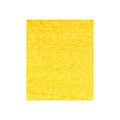Orpiment, shown above in its natural form and also pigment form, was widely used in Egypt during and after the 18th dynasty, about 1500 BC. During this period the very progressive and successful female pharaoh, Hatshepsut, was in power. It is thought that she initiated trade with other countries and the use of orpiment began because of her. Because this canary yellow pigment does not occur naturally in Egypt, it most likely was imported from Asia Minor where it is found.
For many centuries this bright yellow pigment was ground and used in painting and can still be found today. There are many problems to be considered if using this color however. This pigment contains arsenic and is extremely toxic. In addition, it does not combine well with lead or copper based pigments such as azurite and Egyptian blue. It went completely out of favor to artists in the 19th century. Modern day artists have substituted orpiment with the cadmium yellows. I have chosen not to use orpiment in my Egyptian project..


